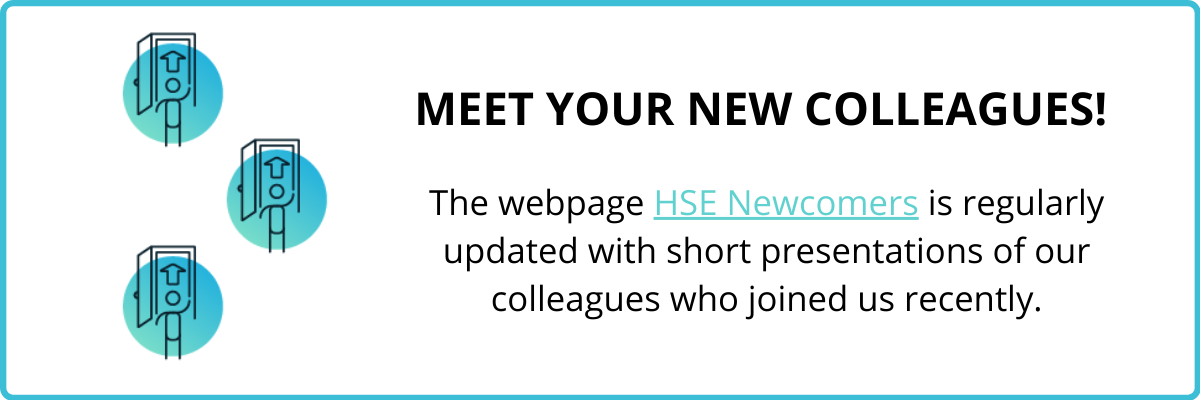
July 2023
Welcome to the HSE Newsletter, the third in a series to be published at least twice a year and featuring some selected highlights for the HSE Unit. You can find the other editions here or in the side menu.
We thank the contributors and encourage anyone who has a newsworthy story to share it with us at hse-comms@cern.ch. We will then publish it on the most appropriate channel, including the CERN Bulletin or the HSE website.
A PDF-version of this newsletter is available on EDMS.
Happy reading!
Contents
Making progress: status of HOR’s WP3 on Medical and personal assistance response
The HSE unit launched its HSE operational response project, known as HOR, in May 2022, whose objective is to design a clear and effective framework for HSE operational response (see the article in the June 2022 HSE newsletter to find out more). We caught up with Raphael Otzenberger, leader of Work Package 3 (WP3) on Medical and personal assistance response to tell us about the work and progress made so far.
Click here to read more
– Raphael, tell us more about HOR WP3.
RO: The objective of WP3 is to review the medical response provided by the HSE unit in the field of occupational medicine, medical monitoring and follow-up of long-term absences from work and in matters of first-line health support to everyone on the CERN site.
– How is the work structured?
RO: We are a team with representatives from HSE (with a legal and Health and Safety focus), the HR department and the Staff association, and two doctors. We have established two phases to structure the work of this group. The first phase aims to design the most appropriate medical environment for CERN. The second phase aims to develop implementation scenarios based on the results of the first phase, and these will ultimately be presented to CERN Management.
– What are the first achievements?
RO: We are progressing well: the first phase is already complete. We drafted a proposal that specifies the key principles of the occupational medicine at CERN, such as the focus on prevention and on risks and particularly on occupational risks. The proposal also outlines an approach for the medical surveillance of MPEs that builds on individual medical visits and targeted prevention measures. The aim is to put in place a medical monitoring programme that makes sense from a medical point of view. The plan is to have this gradually implemented as of next year, 2024. It is a challenge, but I am confident that we can make it.
– What are the challenges you see for the next steps?
RO: When it comes to health, we all have different expectations and opinions. This project is not about doing more or fewer medical consultations, but actually determining and implementing what makes sense from a medical perspective. The mix of individually adapted medical monitoring and targeted prevention actions is a completely new approach for CERN: this change may challenge expectations built on past practices and experience. The other challenge is that this fundamental change requires new tools and revised processes to be fully implemented. And this will require time and dedication!
Melting CERN’s radioactive waste: the successful conclusion of the MAST project
CERN’s scientific activities produce radioactive waste which are generated by the interaction between particle beams and equipment present inside the accelerator complex. This waste consists mainly of large metallic components, cables and ventilation filters, and also includes waste from operations, such as gloves and overalls. These materials are collected mainly during periods of maintenance and consolidation of CERNs facilities. CERN reuses activated material as far as possible, the rest being eliminated in the two Host States, France and Switzerland.
Click here to read more
The disposal of its radioactive waste remains a critical subject for the Organization that produces up to 641 tonnes of radioactive waste per year.
According to the level of activity, CERN radioactive waste is classified as “candidate for clearance”, “very-low-level” (TFA) or as “low- and intermediate-level” (FMA) waste. In the framework the tripartite agreement on radiation protection and radiation safety, CERN eliminates towards Switzerland “candidates for clearance” from radiological control as well as its most radioactive waste that will eventually be stored in the future deep geological repository, while exploiting the full capacity of the French pathways for low- and medium level radioactive waste.
About 90% in volume of all CERN low- and intermediate-level waste is metallic. Setting up a treatment and elimination process for this waste family is therefore critical.
Proven technologies exist to treat FMA metallic radioactive waste. Among them, melting is the most promising: it reduces the waste volume optimally, allows accurate radiological characterisation, achieves detritiation(1) and minimises handling at CERN, as resulting ingots can be directly eliminated from the foundry to the final repository in France.
The Melting of Activated STeel (MAST) project was set up in 2019, as part of the FMA waste elimination strategy, developed in 2018. Its aim was to run a pilot campaign for the treatment and elimination process of CERN’s metallic FMA waste by melting. A pilot batch of 19 m3 of metallic FMA waste was successfully melted at the end of 2022, resulting in 8.3 ingots (1.9 m3) and 0.15 m3 of slag. The pilot ingots were disposed of in the French final repository by June 15, marking the project’s end.
The MAST project has been a key contributor to the opening of an efficient elimination pathway for the yearly disposal of up to 16 m3 of FMA metallic waste in France.
__________
(1) Extracting tritium from equipment or material in which it is present.
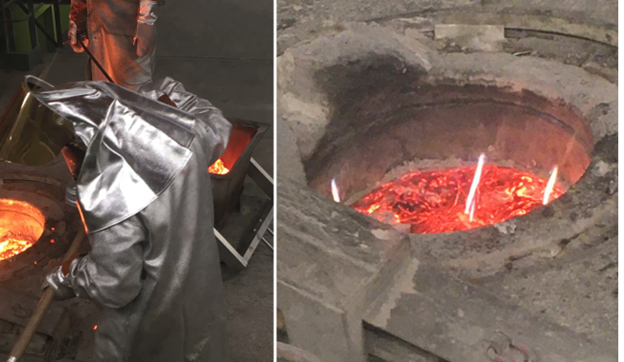 |
Improving radioactive waste sorting
A new video raises awareness on the impact of inappropriate waste disposal.
Click here to read more
Radioactive waste management and sorting bears challenges of a particular nature for the RP group. All CERN’s radioactive waste comes to the Radioactive Waste Treatment Centre and Storage facility, RWTCS. 100 m3 of incinerable waste are received on average each year, 150 m3 in long shutdown years. It is then properly eliminated following established pathways. Dedicated, clearly marked waste bins are available to sort the waste appropriately, and all bags undergo X-ray analysis to ensure no unwelcome objects are present in the process. If they are, this incurs a parallel time-consuming loop in a sorting cell, to remove the offending objects.
As more than 50% of the bags do not meet the requirements, a short video was filmed to show the impact of wrong disposal and raise awareness to minimise the loss of time at the RWTCS. View them in English and French on this link.
Refurbishing CERN’s technical galleries
CERN’s technical galleries are used for distribution network services throughout the campus and/or between buildings. The 80 galleries form a 14 km-long maze and are located just below ground level on the Meyrin and Prévessin sites. Having been in operation for more than 50 years, they are in dire need of an overhaul. This is why the Technical Galleries Consolidation programme (TG-CONS) was approved by the CERN Council in 2020 with a budget of 34 MCHF. The programme was launched in 2021 and will stretch over 12 years.
Click here to read more
The main objectives of the TG-CONS project are to:
- Fix existing issues and refurbish the galleries’ conditions to the extent reasonably possible.
- Prepare for probable future expansions, with respect to CERN’s MasterPlan 2040.
- Further improve the management of safety and environment-related aspects.
The programme covers a multitude of services and networks, such as the heating network, water networks, safety systems, electrical cables, gas pipes, and optical fibres.
Many of CERN’s departments are involved, including the HSE Unit. Safety is a major part of this programme, both throughout its execution and for the future operation of the galleries.
TG-CONS is a unique opportunity to perform a comprehensive safety analysis and assessment and implement the required measures. As an example, there are ongoing studies on ventilation, emergency preparedness, fire safety, and a lead and asbestos analysis. The TG-CONS were invited to the HSE Technical Management Board in April 2023, and you can find all the presentations on the Indico-page (Access key: TMB05042023).
The programme also addresses environmental issues, such as the renovation of the water circuits, carrying drinking water supply but also water used by the CERN Fire & Rescue service. The layout of the drinking water network in the West Area of the Meyrin site have just been completely revised and optimised. Take a tour of your own with a deep dive in this video!
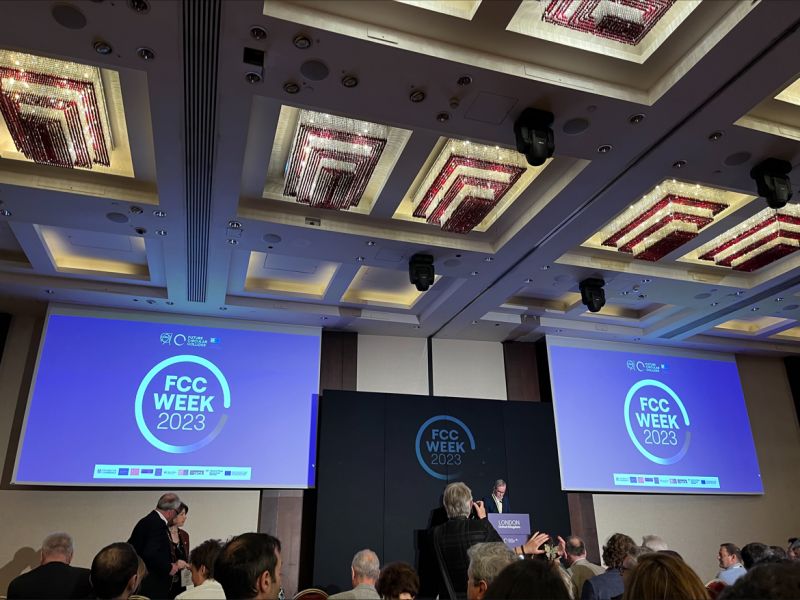 |
|
| FCC week 2023 took place in London in June. (Photo curtesy of Andre Henriques) |
HSE at FCC Week, 5-9 June 2023
Although the LHC will run until the early 2040s, plans for its successor are well underway. The Future Circular Collider (FCC) is the current front-runner, identified through the European Strategy for Particle Physics. The CERN Council mandated CERN to carry out a feasibility study for this future circular collider, who will report on the economic, environmental, geological and technological feasibility of the FCC in 2025. The progress made is remarkable, with sustained momentum and strong support from Host States and other stakeholders.
Click here to read more
This was highlighted at the ninth edition of the Future Circular Collider (FCC) Conference, which took place in London, United Kingdom from 5 to 9 June 2023. The meeting brought together nearly 500 people from the international scientific community and the industry to review the recent progress of the FCC feasibility study, and to set the short-term goals for the coming years.
Benoît Delille, HSE unit Head was present at the event which saw several people from the Unit giving presentations: Luisa Ulrici (HSE-ENV) talked about the excavation materials management strategy, Giacomo Lavezzari (HSE-RP) gave a presentation about the radiation protection studies for the FCC-ee and Andre Henriques (HSE-OHS) gave an overview of the safety systems and evacuation study in the FCC tunnel.
You can find all information about the FCC week and the presentations on the event’s Indico page.
In brief
Get acquainted with the 18 species of orchid thriving on CERN sites
You may have noticed new posters popping up around the site in unexpected places, to inform us of the diverse species of orchid that grow on CERN sites.
Some posters are specific, others show all species to make us aware and mindful not to pick or trample these beautiful flowers, some of which are rare.
Look out for posters such as those shown below and if you want to proactively observe, find the zones of biological interest on the GIS portal (click on Data > Thematic map > Biodiversity > Surfaces d’intérêt écologique (SIE)).
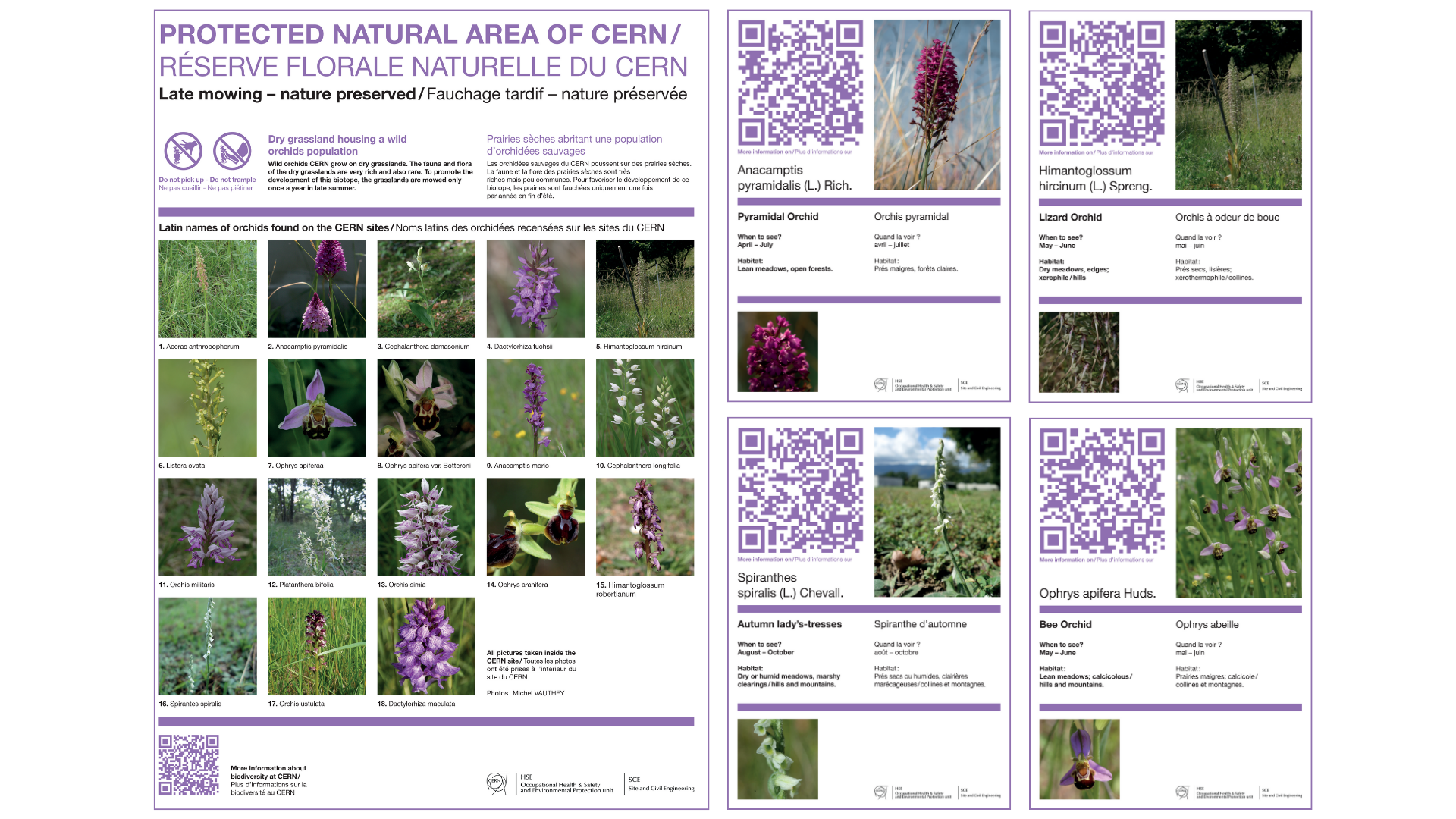 |
|
| New orchid posters will be put up. |
How CERN minimizes its impact on the environment: a new video is launched
A new video to show the many domains in which CERN is active to limit its impact on the environment was published on World Environment Day, 5 June on CERN social media channels. It was relayed by institutes within the European Particle Physics Communication Network (EPPCN) to mark the many ways in which research institutes are contributing. This video will be included on the HSE website as well as home.cern environment webpages.
Click here to expand the video player
A new “Safety for newcomers” flyer is published
Safety starts with us: this is a message we live and breathe in HSE. To better inform all newcomers to CERN of what Safety means and what is expected from them, a new Safety flyer has been produced by HSE-TS-LC together with HSE-TS-ST and widely distributed to ensure the message takes hold among our new colleagues.
You can find it on: English (Web; Print) and French (Web; Print).
News from the CFRS: welcoming a special visitor
Jacques Lissajoux is a former CERN firefighter, who started his career with the Organization in 1960 and stayed until 1994. On the occasion of the ceremony marking the completion of training for our new CFRS colleagues on 12 May, Jacques paid the CFRS a visit and marveled at the evolution of the station, the equipment and CERN as a whole.
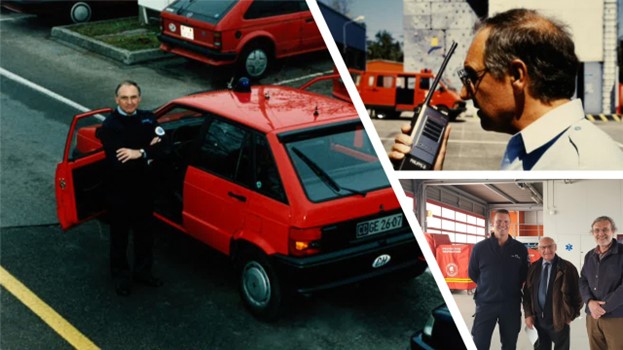 |
|
| Jacques Lissajoux, a former CERN firefighter, came to visit the CERN Fire Brigade in May 2023. |
... And what happened when our new firefighter colleagues went on a walkabout challenge
In April, the Unit was joined by seven new colleagues in the Fire & Rescue service. As last year, the newcomers had a 10-week induction period to get training and acquainted with CERN. One part of this was a walkabout photo challenge where the two teams gathered points for different photos. It ranged from taking a photo with an animal on the Prévessin site to taking a photo with a member of the management (the higher up, the more points). Below you’ll see the result of one part of the challenge: taking a photo with different nationalities.
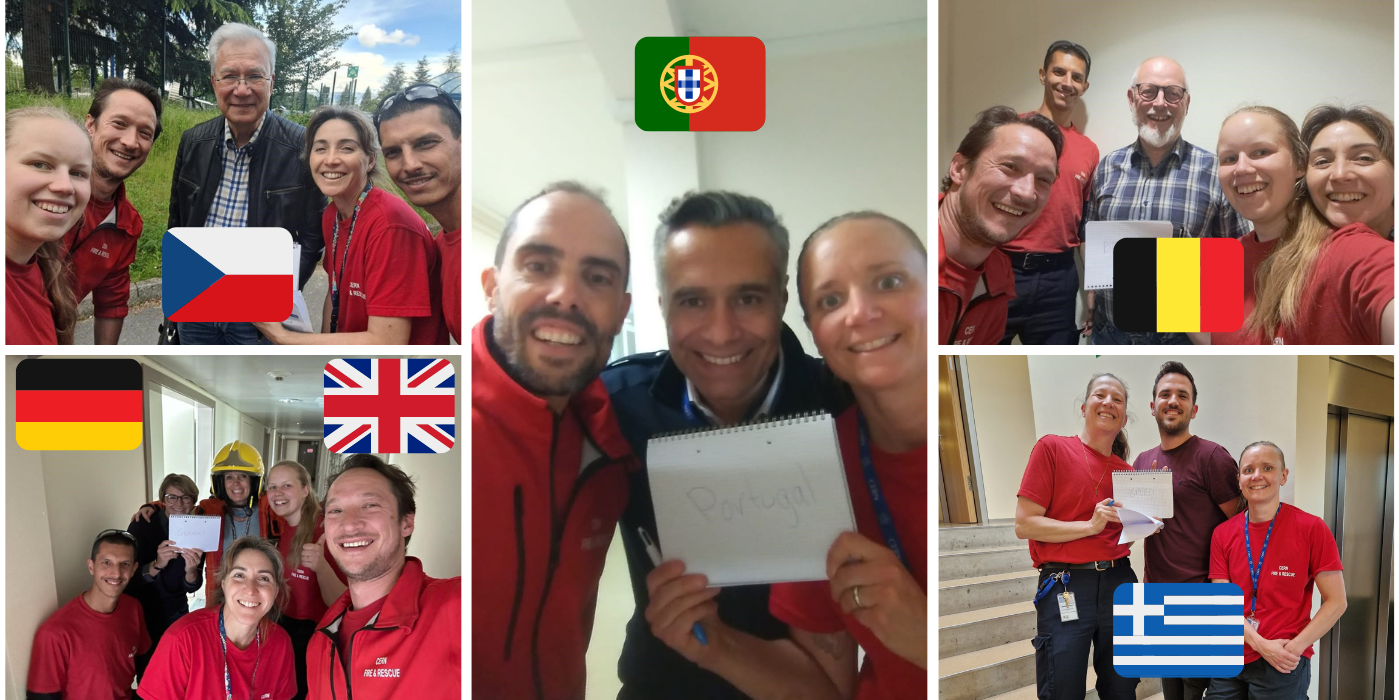 |
|
| The new firefighters managed to find many different nationalities. |
HSE Newcomers
